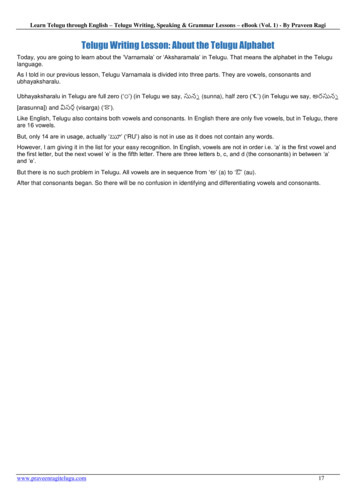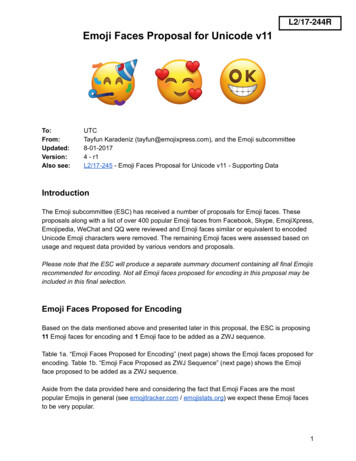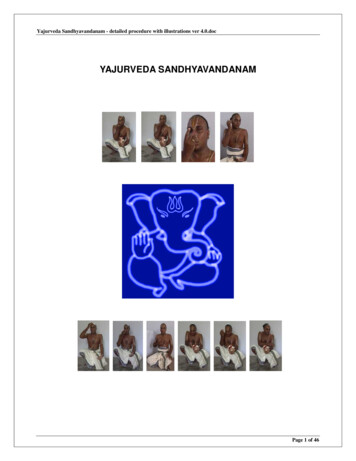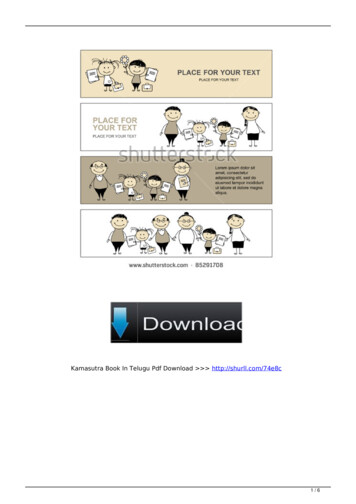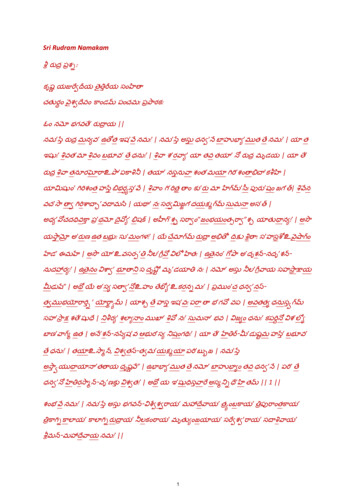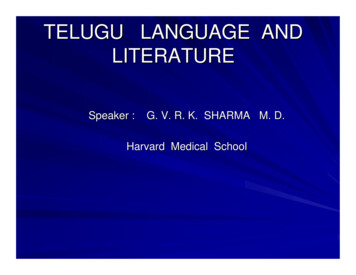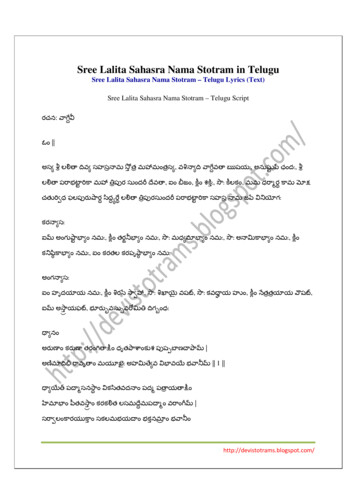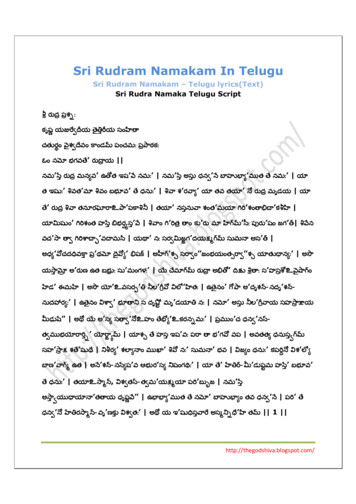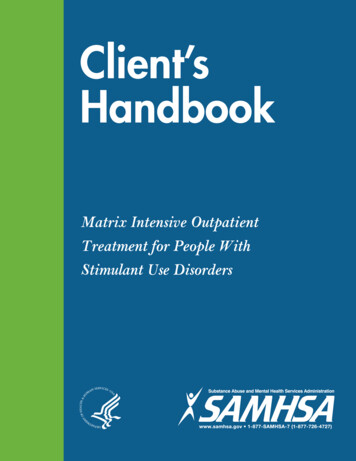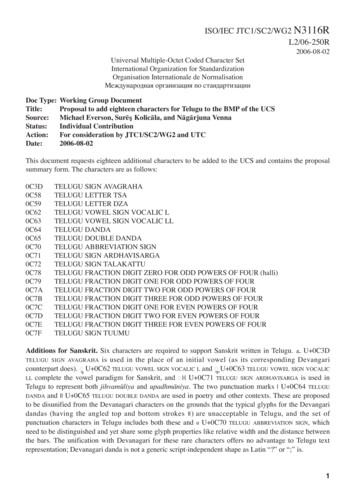
Transcription
ISO/IEC JTC1/SC2/WG2 N3116RL2/06-250R2006-08-02Universal Multiple-Octet Coded Character SetInternational Organization for StandardizationOrganisation Internationale de NormalisationМеждународная организация по стандартизацииDoc Type:Title:Source:Status:Action:Date:Working Group DocumentProposal to add eighteen characters for Telugu to the BMP of the UCSMichael Everson, Surēs. Kolicāla, and Nāgārjuna VennaIndividual ContributionFor consideration by JTC1/SC2/WG2 and UTC2006-08-02This document requests eighteen additional characters to be added to the UCS and contains the proposalsummary form. The characters are as 780C790C7A0C7B0C7C0C7D0C7E0C7FTELUGU SIGN AVAGRAHATELUGU LETTER TSATELUGU LETTER DZATELUGU VOWEL SIGN VOCALIC LTELUGU VOWEL SIGN VOCALIC LLTELUGU DANDATELUGU DOUBLE DANDATELUGU ABBREVIATION SIGNTELUGU SIGN ARDHAVISARGATELUGU SIGN TALAKATTUTELUGU FRACTION DIGIT ZERO FOR ODD POWERS OF FOUR (halli)TELUGU FRACTION DIGIT ONE FOR ODD POWERS OF FOURTELUGU FRACTION DIGIT TWO FOR ODD POWERS OF FOURTELUGU FRACTION DIGIT THREE FOR ODD POWERS OF FOURTELUGU FRACTION DIGIT ONE FOR EVEN POWERS OF FOURTELUGU FRACTION DIGIT TWO FOR EVEN POWERS OF FOURTELUGU FRACTION DIGIT THREE FOR EVEN POWERS OF FOURTELUGU SIGN TUUMUAdditions for Sanskrit. Six characters are required to support Sanskrit written in Telugu. Ω U 0C3DTELUGU SIGN AVAGRAHA is used in the place of an initial vowel (as its corresponding Devangaricounterpart does). @‚ U 0C62 TELUGU VOWEL SIGN VOCALIC L and @„ U 0C63 TELUGU VOWEL SIGN VOCALICLL complete the vowel paradigm for Sanskrit, and @Ò U 0C71 TELUGU SIGN ARDHAVISARGA is used inTelugu to represent both jihvamūliya and upadhmāniya. The two punctuation marks ‰ U 0C64 TELUGUDANDA and  U 0C65 TELUGU DOUBLE DANDA are used in poetry and other contexts. These are proposedto be disunified from the Devanagari characters on the grounds that the typical glyphs for the Devangaridandas (having the angled top and bottom strokes ) are unacceptable in Telugu, and the set ofpunctuation characters in Telugu includes both these and U 0C70 TELUGU ABBREVIATION SIGN, whichneed to be distinguished and yet share some glyph properties like relative width and the distance betweenthe bars. The unification with Devanagari for these rare characters offers no advantage to Telugu textrepresentation; Devanagari danda is not a generic script-independent shape as Latin “?” or “;” is.1
Additions for modern publishing. The first of these characters, as referred to above, is related to thedouble danda: U 0C70 TELUGU ABBREVIATION SIGN is used to mark abbreviations, such for the words“hours”, and “minutes” in wedding invitations and calendars as well as the salutations (in blessing) forthe bride and groom, as in the wedding invitation shown in Figure 7. The second character, Ú U 0C72TELUGU SIGN TALAKATTU, is a glyph fragment used in paedagogic materials to indicate what in someanalyses of the language is a mark of the inherent vowel -a. This is a stand-alone spacing character; it isnot a letter or combining vowel sign and has no combining properties. A letter like ï U 0C15 TELUGULETTER KA bears the inherent vowel; while a grammar may analyze this as fl k Ú a ï ka, there is nocoded character fl *k and *flÚ is not equivalent to ï ka; ï virama Ú is also impossible. The characteris coded in the “Telugu-specific additions” section to underscore its status.Additions for alveolar affricates. Two characters, a voiceless alveolar affricate [ts] ÿ U 0C58 TELUGULETTER TSA and a voiced alveolar affricate [dz] Ÿ U 0C58 TELUGU LETTER DZA are also proposed here.Telugu grammarians have referred to these two characters as “dental variants” of ö CA and ú JArespectively. These characters are commonly found in old grammar books and dictionaries. Historically,various glyphs were used to render these two characters but the notation used currently was proposed byCharles Philip Brown in the 19th century. These letters are not in current use in contemporary Telugu,though many books published over the last 160 years have used the Brown notation. The sorting order ofthese letters is ö CA ÿ TSA õ CHA and ú JA Ÿ DZA ù JHA respectively. The diacritical mark usedfor these two letters is not productive.Additions for measures and arithmetic. The Telugu numeral system is based on using the decimalsystem for writing integers and the quaternary system for writing fractions. Both sytems are positionalnumber systems. Instead of the 4 basic marks that would be expected to be used in a base-4 system, atotal of 8 marks were used. Basically, two different marks were available for writing each of thequaternary digits. One set ( , , ) is used for fractions in positions representing the negative odd powersof 4 (1/4, 2/4, 3/4, 1/64, 2/64, 3/64, 1/1024 etc.); the second set ( , , ) is used for fractions in positions representingthe negative even powers of 4 (1/16, 2/16, 3/16, 1/256, 2/256, 3/256, 1/4096 etc.). Similarly, two different zeros were used zero from the first set is known as hal.li. The zero for the second set is the same as Ê U 0C66 TELUGUDIGIT ZERO. The arithmetic marks for the first set can be understood as represented by perpendicular lines;digit 1 is represented by one such line, 2 by two lines and 3 by three lines. Similarly, the arithmetic marksin the second set can be undersood as represented by horizontal lines; digit 1 is represented by one suchline, 2 by two lines and 3 by three lines. It was not uncommon to have the 4096th part of an integeroccurring in Telugu accounts as evidenced by the fact that fractions up to 3/4096 had given names. Thelargest unit of volume in ancient Telugu land was khaṁd.i or put.ti. A more convinient measure used wasˇ tūmu which represented one twentieth of a put.ti. The actual quantity of a tūmu varied not only fromplace to place but also depending on the substance being measured. As reliable measures of volume werenot developed until the eighteenth century, units of volume were generally named after standardcontainers that were defined by their capacity to hold a given weight of a particulary substance. As such,tūmu can also be regarded as a unit of weight.Additional changes. Just as U 0C02 TELUGU SIGN ANUSVARA is annotated “ sunna” in the UnicodeStandard, we request that U 0C01 TELUGU SIGN CANDRABINDU be annotated “ arasunna”. Moreimportantly, we propose to replace the default chart font entirely. The one currently used is somewhatinconsistent in weight and style; compare the Unicode 4.0 glyphs for U 0C0C, U 0C0E, U 0C0F, andU 0C61 with the rest of the characters, and with the code chart shown below, where we usedK. Desikachary’s fine Open Source font Pothana (http://kavya-nandanam.com/dload.htm).2
Unicode Character F;TELUGUSIGN AVAGRAHA;Lo;0;L;;;;;N;;;;;LETTER TSA;Lo;0;L;;;;;N;;;;;LETTER DZA;Lo;0;L;;;;;N;;;;;VOWEL SIGN VOCALIC L;Mn;0;NSM;;;;;N;;;;;VOWEL SIGN VOCALIC E DANDA;Po;0;L;;;;;N;;;;;ABBREVIATION SIGN;Po;0;L;;;;;N;;;;;SIGN ARDHAVISARGA;Mc;0;L;;;;;N;;;;;SIGN TALAKATTU;So;0;L;;;;;N;;;;;FRACTION DIGIT ZERO FOR ODD POWERS OF FOUR;No;0;L;;;;0;N;;;;;FRACTION DIGIT ONE FOR ODD POWERS OF FOUR;No;0;L;;;;1;N;;;;;FRACTION DIGIT TWO FOR ODD POWERS OF FOUR;No;0;L;;;;2;N;;;;;FRACTION DIGIT THREE FOR ODD POWERS OF FOUR;No;0;L;;;;3;N;;;;;FRACTION DIGIT ONE FOR EVEN POWERS OF FOUR;No;0;L;;;;1;N;;;;;FRACTION DIGIT TWO FOR EVEN POWERS OF FOUR;No;0;L;;;;2;N;;;;;FRACTION DIGIT THREE FOR EVEN POWERS OF FOUR;No;0;L;;;;3;N;;;;;SIGN TUUMU;So;0;L;;;;;N;;;;;BibliographyBammera, Pōtana. 1904 (ca. 15th century CE). Śrı̄ Mahā Bhāgavatamu, Saptama skandhamu. Edited byAllād.i Nārāyan.aśāstrulu. Cennapuri: Rāmānam. da Mudrāks.araśāla.Bammera, Pōtana. 1983 (ca. 15th century CE). Śrı̄ Mahā Bhāgavatamu, Volume 2. Hyderabad: Ām. dhraPradēś Sāhitya Akād.ami.Bhadrirāju, Kr.s.n.amūrti and J. P. L. Gwynn. 1986. A Grammar of Modern Telugu. Oxford UniversityPress. ISBN 0-195-61664-2.Brown, Charles Philip. 1903 (2004). Telugu-English Dictionary Nighaṁt. uvu Telugu-Iṁglı̄s., 2ndedition. Revised by M. Veṁkat.a Ratnaṁ, W. H. Campbell, Kaṁdukūri Vı̄rēśaliṁgaṁ. Chennai: AsianEducational Society. ISBN 81-206-0037-1.Campbell, A. D. 1849 (1991). Grammar of the Teloogoo Language, 3rd Edition. Chennai: AsianEducational Society. ISBN 81-206-0366-4.Cēmakūra, Vēm. kat.arāja. 1911. Vijaya Vilāsamu. Madarasu: Jyōtis.matı̄ Mudrāks.araśāla.Garan.i, Vaiyākaran.a Kr.s.n.ācāryēlu. 1978. Śabdaratnāval.ih. Edited by Ud.āli Subbarāmaśāstri. Hyderabad:Ām. dhra Pradēś Sāhitya Akād.ami.Kākunūri, Appakavi. 1970 (1565). Appakavı̄yamu. Edited by Gid. ugu Rāmamūrthipam. tulu, UtpalaVēm.kat. anarasim.hācāryulu, Rāvūri Doraswāmiśarma. Cennapuri: Vavil.l.a Rāmaswāmisāstrulu Am.d.Sans.Kā l. idāsa. 1998 (ca. 5th century CE ). Edited by Mē l. l. acervu Bhānuprasādarāvu. Dē vı̄ Aśvadhāt.i.Narasāravupēt. a: Mural.i Ārt. Prim. t.ers.Paravastu, Cinnayasūri. 1950 (1858). Bāla Vyākaran.amu. Cennapuri: Vavil.l.a Rāmaswāmiśāstrulu Am. d.Sans.Śrı̄nivāsa, Sōdarulu. 1960. “L.kāra Dı̄rgham.,” Bhārati Sāhitya Māsapatrika, Vol. 37, No. 2 (February1960), pp. 49-52.Vēdamu, Vēm.kat.arāyaśāstri, Dr C. R. Śarma, and Tirumala Rāmacam.dra. 1979. Śrı̄ Ām.dhra Tamil.aKannad.a tribhās.ā nighaṁt.uvu. Hyderabad: Ām. dhra Pradēś Sāhitya Akād.ami.Acknowledgements. The authors are grateful to Vād.apalli Śēs.a Sāyi, Jejjāla Kr.s.n.amōhana Rāvu, andParucūri Śrı̄nivās for their support and assistance in locating examples of the characters.3
FiguresFigure 1. Sample from Kāl.idāsa 1998 showing AVAGRAHA, DANDA, and DOUBLE DANDA.Figure 2. Sample from Bammera 1983 showing AVAGRAHA.Figure 3. Sample from Cēmakūra 1911 showing AVAGRAHA and DANDA.4
Figure 4. Sample from Bammera 1904 showing DANDA and DOUBLE DANDA.Figure 5. Sample from Garan.i 1978 showing ARDHAVISARGA.5
Figure 6. Sample from Paravastu 1950 showing ARDHAVISARGA.Figure 7. Sample from a wedding invitation showing the ABBREVIATION SIGN.6
Figure 8. Sample from Kākunūri 1970 showing VOWEL SIGN VOCALIC L and VOWEL SIGN VOCALIC LL.Figure 9. Sample from Bhadrirāju showing VOWEL SIGN VOCALIC L and VOWEL SIGN VOCALIC LL.Figure 10. Sample from Śrı̄nivāsa 1960 showing VOWEL SIGN VOCALIC LL.7
Figure 11. Sample from Bhadrirāju 1986 showing the SIGN TALAKATTU.Figure 12. Sample from Campbell 1849 showing the SIGN TALAKATTU and VOWEL SIGN VOCALIC L.8
Figure 13. Sample from Brown 1903 showing the LETTER TSA.Figure 14. Sample from Brown 1903 showing the LETTER DZA.9
Figure 15. Sample from Paravastu 1950 showing the letters TSA and DZA.Figure 16. Sample from Vēdamu 1979 showing the letters TSA and DZA.10
Figure 17a. Sample from Campbell 1849 describing the Telugu fractions,showing , , , , , and .11
Figure 17b. Further discussion in Campbell 1849 of the Telugu fractions, showing , , , , , , and .12
Figure 18. Sample from Campbell 1849 discussing Telugu units of measure,showing , , , , , , and ˇ.13
Proposal for the Universal Character SetEverson, Kolichala, VennaTABLE XXX - Row 0C: TELUGU0C000C10C20C30C4ê† @¿0C50C60C7‡ 1@Å @¡· @Ò2@Ç í @ @‚3@É ì @ @„4î §@ƒ‰5Öï µ6Ü ñ¶ @ 7áß @«89óà ò âπô@»@’Â@ ÊÚÁÿ Ë ŸÈ Aä ö @ ÍBã õ @ÀÎ å @ÃÏ Dù Ω@ÕÌ Eé û Æ @æŒÓ FèCúü Ø @øG 00P 00Ô ˇ14
Proposal for the Universal Character SetEverson, Kolichala, VennaTABLE XXX - Row 0C: 64748494A4B4C4D4E4F505152535455565758Group 00Name(This position shall not be used)TELUGU SIGN CANDRABINDU (arasunna)TELUGU SIGN ANUSVARA (sunna)TELUGU SIGN VISARGA(This position shall not be used)TELUGU LETTER ATELUGU LETTER AATELUGU LETTER ITELUGU LETTER IITELUGU LETTER UTELUGU LETTER UUTELUGU LETTER VOCALIC RTELUGU LETTER VOCALIC L(This position shall not be used)TELUGU LETTER ETELUGU LETTER EETELUGU LETTER AI(This position shall not be used)TELUGU LETTER OTELUGU LETTER OOTELUGU LETTER AUTELUGU LETTER KATELUGU LETTER KHATELUGU LETTER GATELUGU LETTER GHATELUGU LETTER NGATELUGU LETTER CATELUGU LETTER CHATELUGU LETTER JATELUGU LETTER JHATELUGU LETTER NYATELUGU LETTER TTATELUGU LETTER TTHATELUGU LETTER DDATELUGU LETTER DDHATELUGU LETTER NNATELUGU LETTER TATELUGU LETTER THATELUGU LETTER DATELUGU LETTER DHATELUGU LETTER NA(This position shall not be used)TELUGU LETTER PATELUGU LETTER PHATELUGU LETTER BATELUGU LETTER BHATELUGU LETTER MATELUGU LETTER YATELUGU LETTER RATELUGU LETTER RRATELUGU LETTER LATELUGU LETTER LLA(This position shall not be used)TELUGU LETTER VATELUGU LETTER SHATELUGU LETTER SSATELUGU LETTER SATELUGU LETTER HA(This position shall not be used)(This position shall not be used)(This position shall not be used)TELUGU SIGN AVAGRAHATELUGU VOWEL SIGN AATELUGU VOWEL SIGN ITELUGU VOWEL SIGN IITELUGU VOWEL SIGN UTELUGU VOWEL SIGN UUTELUGU VOWEL SIGN VOCALIC RTELUGU VOWEL SIGN VOCALIC RR(This position shall not be used)TELUGU VOWEL SIGN ETELUGU VOWEL SIGN EETELUGU VOWEL SIGN AI(This position shall not be used)TELUGU VOWEL SIGN OTELUGU VOWEL SIGN OOTELUGU VOWEL SIGN AUTELUGU SIGN VIRAMA(This position shall not be used)(This position shall not be used)(This position shall not be used)(This position shall not be used)(This position shall not be used)(This position shall not be used)(This position shall not be used)TELUGU LENGTH MARKTELUGU AI LENGTH MARK(This position shall not be used)TELUGU LETTER 6D6E6F707172737475767778TELUGU LETTER DZA(This position shall not be used)(This position shall not be used)(
Telugu to represent both jihvamu liya and upadhma niya. The two punctuation marks ‰ U 0C64 TELUGU DANDA and  U 0C65 TELUGU DOUBLE DANDA are used in poetry and other contexts. These are proposed to be disunified from the Devanagari characters on the grounds that the typical glyphs for the Devangari dandas (having the angled top and bottom strokes ) are unacceptable in
